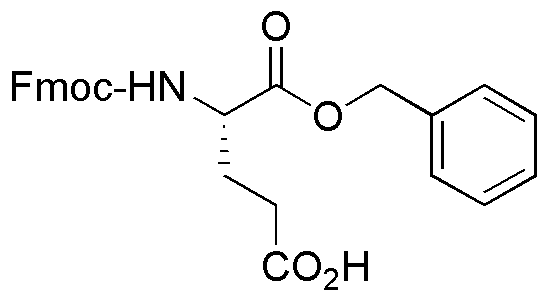Na-Fmoc-L-glutamic acid a-benzyl ester is widely utilized in research focused on:
- Peptide Synthesis: This compound serves as a key building block in the synthesis of peptides, particularly in solid-phase peptide synthesis, allowing for the creation of complex peptide chains with high purity.
- Drug Development: It plays a significant role in pharmaceutical research, where it can be used to develop new drug candidates that target specific biological pathways, enhancing therapeutic efficacy.
- Bioconjugation: The chemical is valuable in bioconjugation techniques, facilitating the attachment of biomolecules to drugs or imaging agents, which improves targeting and reduces side effects.
- Protein Engineering: Researchers utilize it in protein engineering to modify proteins for better stability and activity, which is crucial in developing novel enzymes and therapeutic proteins.
- Academic Research: It is frequently used in academic laboratories for various studies, including the exploration of amino acid functionalities and their interactions in biological systems.
General Information
Properties
Safety and Regulations
Applications
Na-Fmoc-L-glutamic acid a-benzyl ester is widely utilized in research focused on:
- Peptide Synthesis: This compound serves as a key building block in the synthesis of peptides, particularly in solid-phase peptide synthesis, allowing for the creation of complex peptide chains with high purity.
- Drug Development: It plays a significant role in pharmaceutical research, where it can be used to develop new drug candidates that target specific biological pathways, enhancing therapeutic efficacy.
- Bioconjugation: The chemical is valuable in bioconjugation techniques, facilitating the attachment of biomolecules to drugs or imaging agents, which improves targeting and reduces side effects.
- Protein Engineering: Researchers utilize it in protein engineering to modify proteins for better stability and activity, which is crucial in developing novel enzymes and therapeutic proteins.
- Academic Research: It is frequently used in academic laboratories for various studies, including the exploration of amino acid functionalities and their interactions in biological systems.
Documents
Safety Data Sheets (SDS)
The SDS provides comprehensive safety information on handling, storage, and disposal of the product.
Product Specification (PS)
The PS provides a comprehensive breakdown of the product’s properties, including chemical composition, physical state, purity, and storage requirements. It also details acceptable quality ranges and the product's intended applications.
Certificates of Analysis (COA)
Search for Certificates of Analysis (COA) by entering the products Lot Number. Lot and Batch Numbers can be found on a product’s label following the words ‘Lot’ or ‘Batch’.
Número de catálogo
Número de lote/lote
Certificates Of Origin (COO)
This COO confirms the country where the product was manufactured, and also details the materials and components used in it and whether it is derived from natural, synthetic, or other specific sources. This certificate may be required for customs, trade, and regulatory compliance.
Número de catálogo
Número de lote/lote
Safety Data Sheets (SDS)
The SDS provides comprehensive safety information on handling, storage, and disposal of the product.
DownloadProduct Specification (PS)
The PS provides a comprehensive breakdown of the product’s properties, including chemical composition, physical state, purity, and storage requirements. It also details acceptable quality ranges and the product's intended applications.
DownloadCertificates of Analysis (COA)
Search for Certificates of Analysis (COA) by entering the products Lot Number. Lot and Batch Numbers can be found on a product’s label following the words ‘Lot’ or ‘Batch’.
Número de catálogo
Número de lote/lote
Certificates Of Origin (COO)
This COO confirms the country where the product was manufactured, and also details the materials and components used in it and whether it is derived from natural, synthetic, or other specific sources. This certificate may be required for customs, trade, and regulatory compliance.


